#zuiyo
Explore tagged Tumblr posts
Text

Zuiyo Blue Moomin and Pink Snorkmaiden Viynl Figures
#png#transparent#kidcore#nostalgia#nostalgiacore#toycore#toywave#toys#moomin#snorkmaiden#japan#zuiyo#viynl
429 notes
·
View notes
Text
Wet Beast Wednesday: basking shark
I'm not feeling too motivated today, so, I'm going to discuss another animal that likes to take it easy: the basking shark. This shark decided it's not into that whole "hunt down prey and fight to live" thing and decided to become a filter feeder instead. It seems to have worked out too, as basking sharks can be found worldwide and are the second largest fish, surpassed only by the whale shark. There is only one extant species of basking shark, but a few extinct species have been discovered.
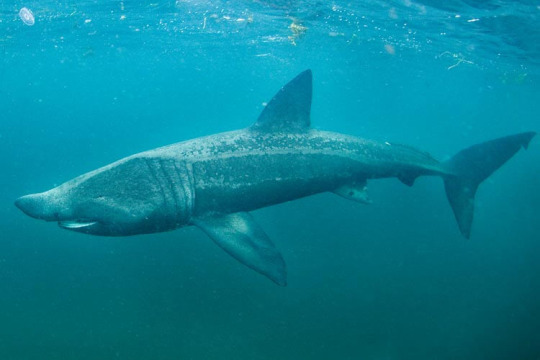
(image id: a basking shark seen from the side. It is a large, brown shark with a large head and pointed snout. Its mouth is closed)
Cetorhinus maximus is one of only 3 species of filter-feeding shark, the others being the whale shark and the awesomely-named megamouth shark. Basking sharks average 8 meters (26 ft) in length, but can reach up to 11 meters (36 ft). An average adult weighs around 4650 kg (5 tons). They have a typical shark body shape (which has led to them being mistaken for great white sharks), but the mouth anatomy is different. The mouth can open up to a meter wide and appears toothless, though it is actually filled with tiny, conical teeth that appear to serve no purpose in adults. The gill slits are longer than in most shark species and almost completely encircle the head. Like other filter-feeding fish, the basking shark's gills are also used to catch its food. It swims forward with its mouth open and as water passed over the gills, zooplankton and small invertebrates and fish will get caught in the gill rakers, from where they can be swallowed. The basking shark's favorite food is copepods of the order Calanoida, though they will also target other copepods. They can detect their prey with electroreception like other sharks. Because plankton is not known for being fast and adult basking sharks have no natural predators, they aren't known for being particularly speedy. A basking shark on the hunt moves at a blistering 3 km/hr (1.9mph). They can move in fast bursts of speed and occasionally can jump clear out of the water. It's not 100% clear why they breach, but it seems to have a few benefits. It can help dislodge parasites (which is a big issue for basking sharks. They are often covered with scars from lampreys and cookie-cutter sharks) and notably they breach more during mating season, so it may also be used for sexual display. Breaching and the resulting splash may also be used for long-distance communication and threat displays. I remember being a kid watching Shark Week and being told by the TV that great whites are the only shark species that breach and that was just not even remotely true. The basking shark has the lowest brain to body weight ratio of any shark.
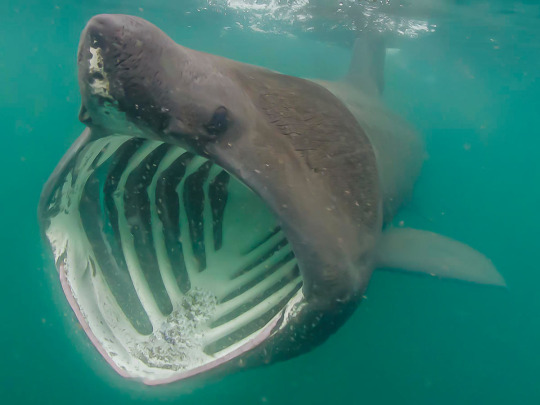
(image id: a basing shark seen from the front with its mouth open. The mouth is very large and white on the inside. Its gill slits can be seen from the inside, looking like large slits in the side of the mouth)
youtube
(video: a basking shark leaping out of the water multiple times)
The name basking shark comes from their typical behavior. They swim slowly at the surface of the water while feeding, leading to sailors thinking they were basking in the sun. They were commonly called sunfish, but the name is no longer commonly used to avoid confusion with the ocean sunfish. While swimming at the surface, they sometimes spin around or swim belly-up. Basking sharks are migratory, traveling toward the poles in summer and toward the equator in winter. It was formerly believed that they hibernated over the winter, but it is now known that they spend their time in deep water. While migrating and in summer, basking sharks display social behavior. They will shoal in groups hundreds strong and can often be found in small groups of similarly-sized fish, usually of the same sex. Not much is known about basking shark mating. They are ovoviviparous, with eggs hatching internally and developing further inside the mother before the pups are born. Gestation is believed to take between 1 and 3 years and a few large pups are born at a time. Pregnant females are very rarely seen and they may spend their time in deep water. There is only a single reported example of a pregnant female being caught and it has 6 pups. The seemingly useless teeth may actually be used in utero, as the unborn pups likely feed on unfertilized eggs after their yolk sacs are consumed. This adaptation has been observed in other ovoviviparous sharks. While females have two ova, only the right one actually functions. The lifespan of basking sharks is estimated to be around 50 years.
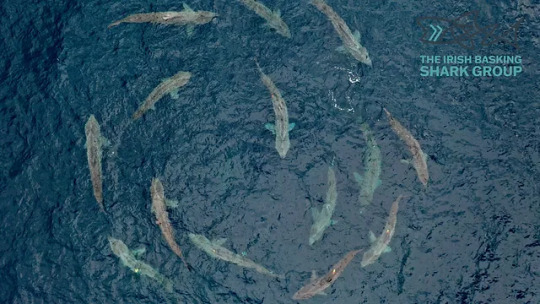
(image id: a group of 14 basking sharks swimming in a circle, seed form above. It is believed that this is a mating display)
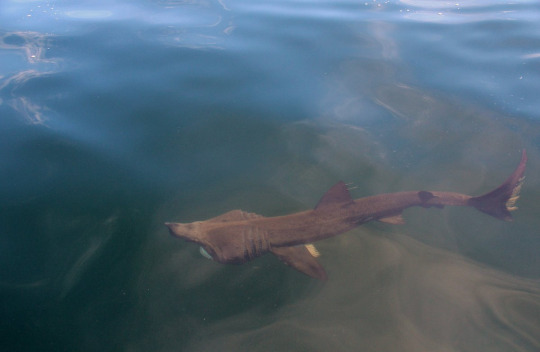
(image id: a juvenile basking shark seen from above. It can be distringuished from an adult by the snout, which is sharp and hooked)
Basking sharks are classified as endangered by the IUCN. They has historically been hunted for their meat, hides, fatty livers, and fins. While there is currently no commercial fishery of basking sharks, they are poached for their fins and have not recovered from overexploitation. Bycatch is an ongoing problem for the sharks. Multiple countries have enacted conservation efforts including legal protection and the enactment of protected areas where fishing is prohibited. Basking sharks pose no threat to humans. They also do not fear humans and have even been known to approach and swim around divers. Basking sharks also appear a lot in the pseudoscience of cryptozoology. I can go into why cryptozoology is a pseudoscience in more detail in another post, but its the study of alleged animals not recognized by science. Basking sharks show up a lot as globsters, unidentified corpses that wash up on beaches or are caught in fishing nets. Basking sharks are responsible for a lot of globsters due to the way their corpses decay. Large amounts of decay happen around the head, which can lead to the mandible bones hanging loose or detaching and the snout decaying to look like a small head on a neck. In addition, the claspers (reproductive organs) of male basking sharks are very large and can be mistaken for limbs. One likely example of this is the Stronsay beast of 1808. Described as a six-legged decaying sea serpent, it is likely that the legs were actually the jaw bones, fins, and claspers of a male basing shark. A more recent example is the Zuiyo-Maru plesiosaur (warning: picture below and it's gross). This carcass was pulled up by the Japanese fishing boat Zuiyō-Maru in 1977 and based on the pictures taken and the word of two Japanese scientists, was thought by some to be an example of a recently-deceased plesiosaur. While the carcass itself was thrown back overboard, some samples were taken for analysis and based on them and anatomical detains from the pictures, it was concluded that the carcass is actually a heavily-decayed basking shark. The "neck" of the carcass is the spine and brain case with the jaws having decayed and fallen off. Further anatomical details such as the presence of cartilage in the fins and body proportions support the carcass being a fin and do not support it being a plesiosaur.
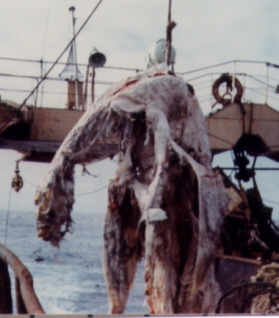
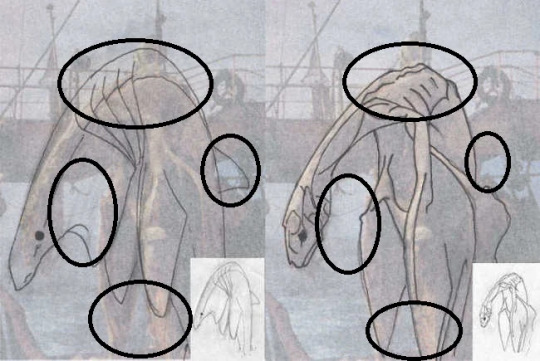
(Image id: top: the Zuiyo-Maru carcass, a large, decomposed carcass hanging rom a hook. It appears to have a long neck and fins. Bottom: a diagram comparing the anatomical features of the carcass and a fresh basking shark)
#wet beast wednesday#basking shark#shark#sharks#fish#fishblr#fishposting#marine biology#biology#zoology#ecology#animal facts#cryptozoology#cryptid#zuiyo-maru plesiosaur#cw animal death#cw dead animal#Youtube
286 notes
·
View notes
Text

On April 25, 1977, the Japanese trawler Zuiyō Maru, reeled in a strange, decomposing creature. The body, later called the Zuiyō Maru Carcass was pulled up east of Christchurch, New Zealand. The corpse weighed in at nearly 4,000 pounds and was 42 feet long.
According to the trawler’s crew, the creature’s neck was 5 feet long, its tail was 6.5 feet long, it had 4 red colored fins and was lacking all internal organs, a dorsal fin and most of its skin. The creature was tossed back into the ocean out of worry for the crew’s cargo being contaminated. It smelled so much like rotting flesh, the crew couldn’t handle it for too long. Some samples of the skeleton, flesh, and fins were taken. Analysis of the samples, photos, and sketches of the carcass caused some scientists to believe the creature was a decomposing basking shark.
However some people still think that the creature was “not a fish, whale, or any other mammal”.
19 notes
·
View notes
Text

*opens the door slightly* hi besties its been a while
#snufkinverse#1969 moomin#1969 snufkin#60s snufkin#zuiyo snufkin#purble art#btw zuiyo is the name of the studio that worked on this series#at least one of them#ive decided to name him that way but in the story everybody be calling eachother snufkin#they. do not care for nicknames i fear LMAO
7 notes
·
View notes
Text
That post about death note being "everyone's first anime" (untrue statement) made me curious and now I want to gather data for science
Can you reblog this and tell me where are you from and what was your starter anime?
#it'll be easier if you look up Zuiyo Enterprises on wikipedia#it's the studio Hayao Miyazaki worked at before his career kicked off#anime
128K notes
·
View notes
Text



Headcanon: Percy loves Basking Sharks.
This happened cause I was looking at info on the Zuiyo-maru carcass, a Basking Shark carcass that many insisted was a Plesiosaur carcass, and when I got my drawing book out, my partner asked me to draw Percy.
So I drew Percy with a Basking Shark and it turned into him having an obsession with them, annoying Annabeth and delighting Grover in the process XD
#traditional art#traditional drawing#traditional sketch#sketch#art#percy jackson#percy jackon and the olympians#percy pjo#percy and annabeth#grover pjo#grover underwood#percy and grover#annabeth chase#annabeth pjo#i love sharks#basking shark#shark
23 notes
·
View notes
Text


left: zuiyo-maru carcass (1977), right: chocolate pudding (2024)
#news from the cupola#globster#IT'S NOT SUPPOSED TO SLITHER OUT OF THE BOWL IN ONE THICK SKIN LIKE THAT....#I feel. Bad. reallyreally not fantastic.
13 notes
·
View notes
Text
tagged by @n0rk0ttik06 to post: an animal, place, plant, character, season, hobby, color, crystal & food that remind me of myself,









zuiyo-maru carcass, fantoft (norway), wych elm, syd (antiviral), winter, having fun, black, tigers eye, nothing
tagging: @zombifiedcorpses @disruptxrr @rottingfamily @wormchaser ..anyone else can just lie n say i tagged them
15 notes
·
View notes
Photo


Mystery Museam series 3: Zuiyo Maru Carass
“This collection produced by Medicom Toy, Japan is truly fantastic. This series is out of production since 2002 and hard to find. There are currently FOUR parts to this series of amazing figures.”
“Each figure is polyvinyl resin/plastic and stands approximately 3 inches. Decayed Long Neck Dragon (a Globster thought by some to be a decayed plesiosaur netted by Japanese fishing boat Zuiyo-Maru off New Zealand in 1977)”
14 notes
·
View notes
Text
Obscure Animation Subject #62: Ninpū Kamui Gaiden
Originally posted on Twitter on April 22, 2023.
Based on the 1964 manga Kamui, this is a collaboration between TCJ and new-comer Zuiyo, the latter’s very first show. It aired from April 6 to September 28, 1969 on Fuji TV every Sunday at 6:30 PM, replacing GeGeGe no Kitarō.
By the end of the series, it was replaced by TCJ’s own Sazae-san, which would later become extremely popular to the point where its still ongoing on its timeslot and now the longest-running animated television series of all time! It’s not The Simpsons, it’s Sazae!
Anyways, back on topic! Set in feudal Japan, it tells the story of a low-born ninja who has fled his clan. The series combines historical adventure with social commentary and themes of oppression and rebellion that reflect Shirato's Marxist convictions. Hmmm, sounds like the social commentary bit would later go into Sazae huh? Looks like most of the Sazae crew has worked on Kamui. Though, their completely different in style and tone. Otherwise, Kamui had 26 22-minute episodes produced and one of them was actually dubbed in English!
No kidding! An episode was dubbed to English and was released as a VHS bundle by REMCO under their Secret of the Ninja toyline. Only dubbed to cash-grab really. A Spanish dub was produced too and that wasn’t a cash grab! BRUH LOOOOOOOOOOOOOOOOOOOOOOOOOOOOOOOOOOOOL!
There isn’t really much more I could say. It was cancelled thanks to low ratings and although a second season was planned, it got scrapped. The timeslot got a lot of its audience boosted thanks to Sazae. FUN FACT: Sazae was planned for the 7:30 slot but Moomin took it instead.


2 notes
·
View notes
Text
Me needing to budget and rebuild my savings vs Zuiyo maru carcass toy 2002 80 dollars.
3 notes
·
View notes
Text

Original Template: https://www.deviantart.com/niklasm15/art/Moomin-Prefers-meme-1016968938
Credit Goes To @themasteroffan
The Moomins/Mumintrollen Belongs To Tove Jansson, Moomin Characters Oy Ltd. King Features Syndicate, Inc. Hearst Communications, Inc. Drawn & Quarterly, Macmillan Publishers, Farrar, Straus and Giroux, And Schildts Förlags AB
Moomin (1969 TV series) Belongs To Tove Jansson, ZUIYO Co., Ltd. TMS Entertainment Co., Ltd. Far Eastern Animation, Mushi Production, Moomin Characters Oy Ltd. Kindernet Entertainment Oy, Fuji Television Network, Inc. Telescreen Japan Inc. Teleimage Japan Inc. Telecable Benelux B.V. TV Tokyo Holdings Corporation, Yleisradio (YLE), Marina Productions, Société Dargaud, Televisión Española (TVE), Radiotelevisión Española (RTVE), BBC Television, BBC Worldwide Ltd. BBC Studios Ltd. And British Broadcasting Corporation (BBC)
1 note
·
View note
Text
Nobody's boy: Remi
In one of the classes about Hayao Miyazaki’s legacy, the teacher spoke about his work in the production of Heidi and Marco in the 70’s when he was working for Nippon Animation (Zuiyo Eizo then). Talking about these old anime reminded me of one that I watched with my mom when I was a lot younger and I remembered that it was also made around those years. The anime was called Nobody’s boy: Remi (or Ie Naki Ko in its original Japanese title).

I never got quite interested in knowing more about what I watched about Remi in those times, but when I heard about Hayao’s influence over Heidi and Marco I wanted to know more about the origins of this sad story.
Before I get into what I found about Remi, for those who didn’t know about this old school anime, I’ll give you a little summary without spoilers:
The story revolves around Remi, a French little boy who, for reasons that unveil as the story progress, ends up with an adoptive family where the father, a very ambitious man, rejects him, selling him to a kind-hearted traveling actor, Mr. Vitalis. Remi starts his adventures through the country with Mr. Vitalis and his animal troupe of entertainers: Capi the labrador, Zerbino the doberman, Dolce the poodle and the amusing monkey Joli-coeur (or Joyful Heart -Corazón Alegre- as I knew him in the Latin dub). With those he consider his new family, Remi has to face the hardships of a traveling actor, living through many tragedies and learning the harsh lessons of life.

Regarding to its production, the anime of Remi is based on the book ‘Sans Famille’, written by the French author Hector Merlot in 1878. It was brought to TV by TMS Entertainment and Madhouse in 1977, with the ex-Mushi Pro animator Osamu Dezaki as its director, the same who worked on Space Adventure Cobra and many others well-known anime, movies and OVAs. It has 51 episodes that lasts 23 minutes each one.
You could say that Remi follows a common recipe among anime like Heidi and Marco: based on an European novel about a child who is stripped of a normal and happy childhood, without parents, forced to face harsh situations that could make anyone cry. Maybe Remi didn’t have the impact that Heidi, Marco or Candy Candy had on the people who watched them in the 70’s and later, but it surely was special for me. Not only because the story left an impression on my younger self due to the heart-wrenching circumstances that Remi had to live through, but also because of how watching it became a reason to share a special moment with my mother, who also enjoyed it when she was a child and later, with me.

-Francisca Rivera C.
1 note
·
View note
Text
Discovery aboard the Zuiyo Maru
In the heart of the boundless ocean, where the waves whispered secrets and untold wonders lurked beneath the surface, a band of seasoned fishermen embarked on yet another day’s work aboard the Zuio Maru. Their weathered faces reflected a familiarity with the unpredictable sea, but this particular day would be etched into their memories as a harrowing encounter with something from the…

View On WordPress
1 note
·
View note
Text


More zuiyo snufkin
#snufkinverse#60s snufkin#1960s snufkin#1969 snufkin#zuiyo snufkin#tw shirtless#tw smoking#purble art#tw unsafe binding#tfw you were raised to be as self sufficient as possible and asking for help is comparable to asking to be shot#he has issues
2 notes
·
View notes
Text
Probably copyright reasons.
The company that made Heidi, Zuiyo Eizo, split into two companies: Nippon Animation, which would continue the official WMT brand (which until that point was known as Calpis Comic Theater), and Zuiyo Company, which kept the actual rights to Heidi.
Heidi doesn't seem to appear in official art of World Masterpiece Theatre protagonists. I guess even though everyone considers it the start of World Masterpiece Theatre it isn't officially part of it/they don't have the rights?
Funnily enough though Anne sometimes appears twice.
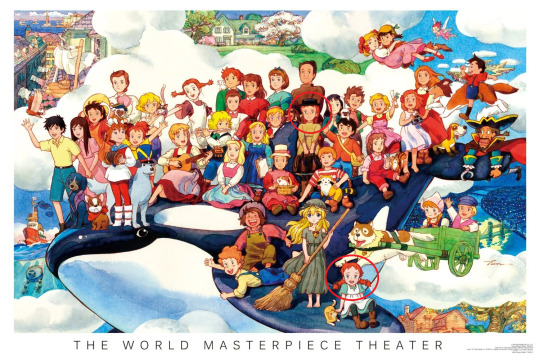
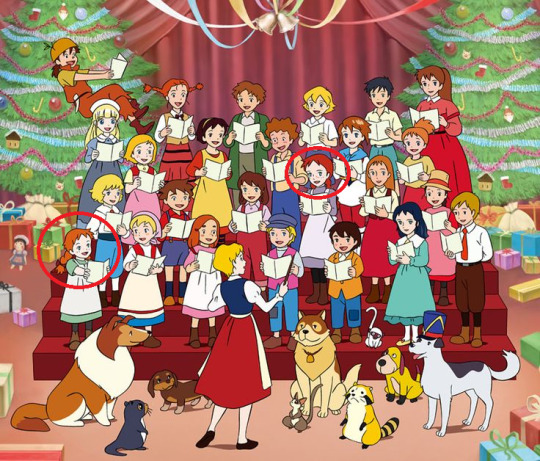
youtube
46 notes
·
View notes